Cleveland starter Shane Bieber is one of the most dominant pitchers in baseball, and we probably don't need to go much beyond "he just won the American League Cy Young unanimously" to back that up. We will anyway, though; he allowed only 14 earned runs in 12 starts in 2020; in 77 1/3 innings, he struck out 122. Over the past two years, he's got a 2.84 ERA and more than six times as many strikeouts as walks. He's in a rare class of elite ace.
OK, but: Why? What does he do so well? Let's try to get into something new.
What makes Bieber an ace?
It's not velocity alone. While hardly a soft tosser, his 2020 average of 94.1 mph on the four-seamer is roughly the Major League average. It's not raw spin rate; he's in the 78th percentile on the fastball and a below-average 29th percentile on the curve. It's some about great control -- as he's got the eighth-lowest walk rate over the past three seasons -- and about he's able to get above-average movement on each of his five pitches despite a lack of elite spin and about how he has five good pitches he can rely on.
But there's a lot more to it, too. Let's let the experts explain it. Before the season began, after Bieber had all of one good full big league season, his name kept coming up when Major Leaguers were asked to guess who the best pitcher of the upcoming decade would be. That stood out.
Then in August, Cleveland manager Terry Francona told MLB.com that "I don't think I've ever seen this with a pitcher where he's got a curveball and a slider that are almost the identical speed that just have different break," and Francona has managed staffs that included Pedro Martinez, Curt Schilling, Josh Beckett, Jon Lester and Corey Kluber. He's seen some pitching.
Then-Tigers manager Ron Gardenhire had high praise as well. “He's got a great cutter off of his fastball. His fastball's 93-94 mph, and then he cuts it out of the same delivery, and it's really tough.”
They're talking about how the curveball plays off the slider and how the cutter plays off the four-seam, and although neither explicitly said it, we're going to also talk about how the curveball plays off the four-seam, too.
To do that, we're going to show you a new tool that's available on Baseball Savant. Entering the 2020 season, the hardware that powers Statcast was removed and replaced, now powered by 12 Hawk-Eye cameras. The initial result of that was a marked improvement in the number of batted balls being tracked -- nearly 100% in 2020 -- and an introductory look at what we called "pose tracking," with promises of more to come.
One of those things that it can also do that the previous version could not is to directly measure the direction of pitch spin, as opposed to merely making an educated guess -- inferring it -- as had been done in the past. (You can read more on this from MLB.com's Tom Tango here.) And that allows us to make images like this, from the batter's point of view:
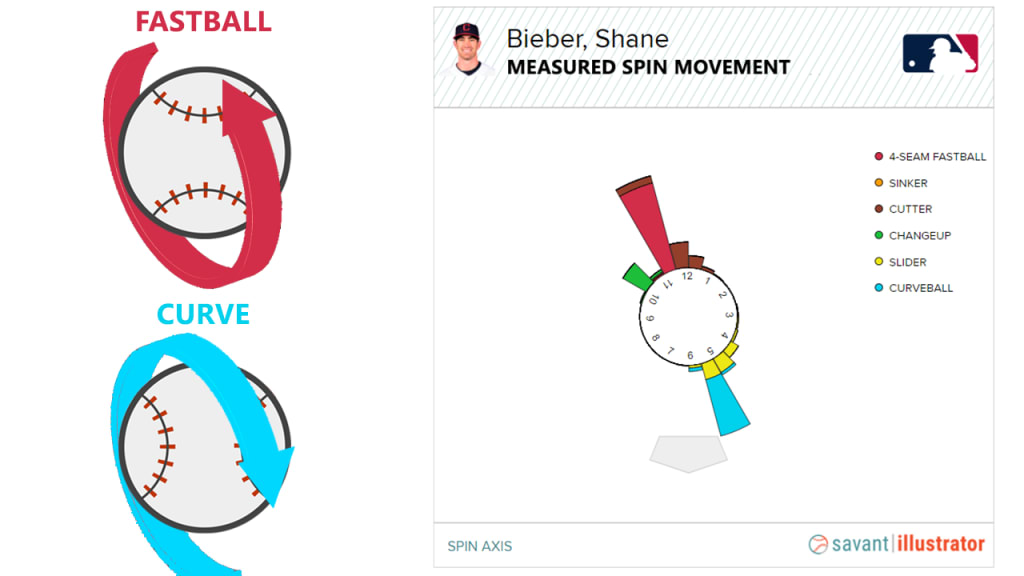
What on earth does any of that mean? Let's explain.
A fastball that mirrors a curveball
Each "slice" here is 30 minutes, with time chosen over degrees simply because it's easier to take in. So you can say here that Bieber's four-seam spin is 11:00, while his curveball spin is at 5:00. The changeup is 10:00, and while his other two pitches are a little more spread out, we can say his average cutter is 11:30 and his slider is 4:30.
The first thing to notice is that Bieber's four-seamer (11:00) and his curveball (5:00) are mirror images of one another. They're 6:00, or 180 degrees, apart. They're opposites, in the sense that his curveball spins exactly the opposite direction that his fastball does.
That's called "pitch mirroring," and it's something pitchers strive for. "What I’m thinking," said Dodgers prospect Josiah Gray to MLB.com last summer about his curveball, "is just try to keep the same arm slot as always so it can mirror my fastball. With emphasis on top spin, it will, more often than not, come out and fall off the same plane as my fastball."
Or think about what Rich Hill said to Eno Sarris back in 2016. “I want my spin on the curveball to be straight down, and my spin on the fastball to be straight up." (Hill thinks about this a lot. That same year, he told Baseball Prospectus that "looking at your pitch axis and trying the mirroring effect of having your curveball on the same axis as your fastball is really what leads to the ultimate deception." The ultimate deception is quite a description.)
Bieber's isn't quite straight up and down -- Hill's, for what it's worth, wasn't either in 2020, the only year we have data on this -- but since they're on the same axis just in different directions, one spinning forward and one spinning backwards, the seams are incredibly difficult to tell apart. Just take a look at this GIF here, made by Michael Augustine, and admit you absolutely cannot tell which one is spinning with topspin (curve) and which one has backspin (fastball).
That being the case, it might help explain why Bieber's fastball/curve combination is so lethal. This isn't the only reason why Bieber had the best (tied) curveball in baseball in 2020, but it sure doesn't hurt.
There's a few dozen other pitchers who have that perfect four-seam/curveball mirror combination down, including Aaron Nola, Joe Musgrove, Drew Pomeranz -- who we called out last winter for dominating with just a four-seamer and a curve, in advance of his four-year contract -- and our personal favorite, Cleveland's two-pitch monster and Bieber's teammate, James Karinchak.
Now go back to what Francona said, about having never seen "a pitcher where he's got a curveball and a slider that are almost the identical speed that just have different break."
A curveball that spins like a slider
Let's refer refer back to the image above. The slider comes out at a 4:30 spin direction, and the curveball at 5:00, which is just this side of identical.
Francona's right about the "identical speed," since the slider is 84.5 mph and the curve is 83.6 mph. But as he noted, they definitely have different break, wildly so. The slider drops 42 inches (that's 4.7 more than sliders at similar speed) with barely any horizontal break. The curveball drops 53.6 inches (that's 6.2 more than curves at similar speed, which is very good) with 9 inches of horizontal break. Different break indeed.
Bieber is one of a handful of pitchers with a slider/curve combo within :30 of one another, with some of the other names including Patrick Corbin (whose curve is really just a slower slider anyway) and Sonny Gray. (And Jordan Yamamoto, who has a career 6.20 ERA. While useful, we're not saying this is The One True Trick to success.)
But he's one of just four pitchers who have both of the things we just talked about -- perfect four-seam/curveball mirror spin and a curve/slider combination with near-identical (within :30) release spin direction, with minimum of 50 of each type thrown.
• Shane Bieber (Cleveland)
• Joe Musgrove (Pittsburgh)
• Alec Mills (Cubs)
• Luke Jackson (Atlanta)
None of them are Bieber, obviously, but they're each interesting. Mills threw a no-hitter in September, while Musgrove just struck out 55 batters in 39 2/3 innings and is an under-the-radar trade candidate this winter. Jackson had a down 2020, but leaning on that slider in 2019, he whiffed 106 in 72 2/3 innings.
So you get the idea. Here's Gerrit Cole, and Clayton Kershaw, and Blake Snell, and all of the White Sox, and all of the sliders, and it can really be sliced and diced however you like. The idea isn't necessarily new, of course. The concept has been explored at FanGraphs, Driveline Baseball, the Athletic and elsewhere. This is just an easier tool to get Major League in-game data out of.
But wait, let's not forget about what Gardenhire said -- about the cutter playing off the four-seamer, how it "cuts it out of the same delivery." Let's talk about that for a second. As we noted above, the four-seamer has an 11:00 spin direction, while the cutter is 11:30, so very similar.
Take a look at them. They are clearly not similar at the plate if you're the unfortunate hitter.
That's a little about velocity, because the four-seamer is 94.1, while the cutter -- new in 2020 -- was 89.3. But let's also bring in another chart here, which is comparing the observed movement from spin direction at the plate (on the left in the chart below) with the spin-based movement out of the pitcher's hand (on the right).
That's a fancy way of saying "how is the actual movement at the plate different from what the original spin direction would have suggested?"
You can see the fastball (bright red) doesn't really change much; it's released at 11:00, and it arrives at the plate at 11:00. But the cutter (dark red) does change on the way to the plate; it's released at 11:30, and arrives at 12:30, on average, and sometimes all the way down to 2:30. In and of itself, this isn't necessarily rare, because other pitchers have that with their cutters, too. It just shows why it might be hard to pick up the difference out of the hand.

Let's take that idea and look at some other notable pitchers.
Where Lynn, Castillo, and Hendricks stand out
For example, here's Lance Lynn, famous for throwing one of his various fastballs 90% of the time. They all come out the same, in terms of spin direction, between 11:00 and 12:00. But by the time they get to the plate, the movement is such that they're from 9:45 (sinker) to 11:15 (four-seamer) to 12:45 (cutter). They change spin direction. They have different movement profiles. What's a hitter supposed to do with that?
Remember: On the left is the spin direction as it's inferred by movement at the plate, and on the right is what's actually directly measured out of the pitcher's hand.
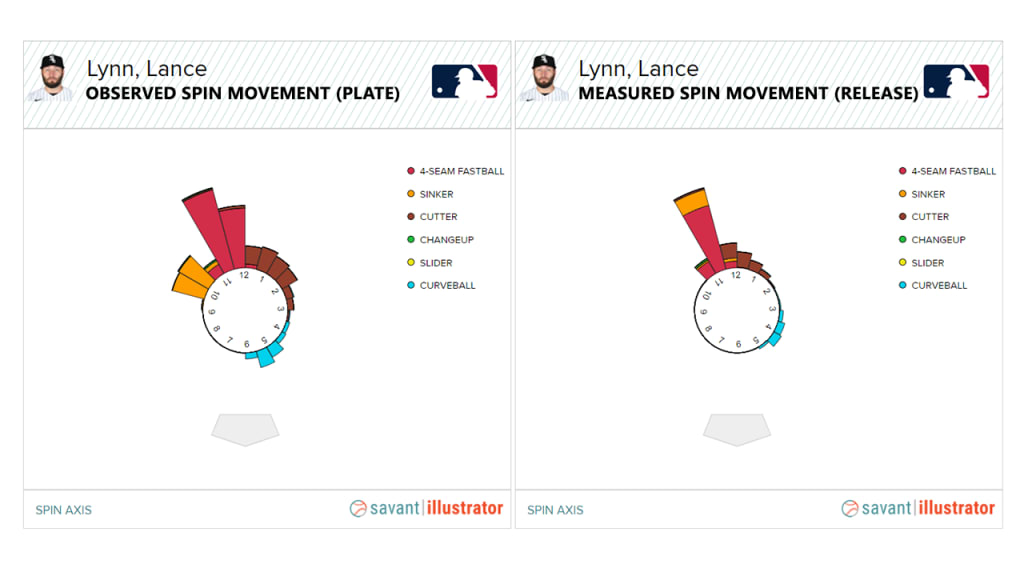
Or Cincinnati's Luis Castillo, famous for his lethal changeup. When he releases it (right), the changeup has similar-ish spin to his four-seamer and sinker. By the time it's at the plate (left), the sinker and changeup have diverged from the four-seam, and while they look similar to one another, there's now an 8 mph gap in velocity.
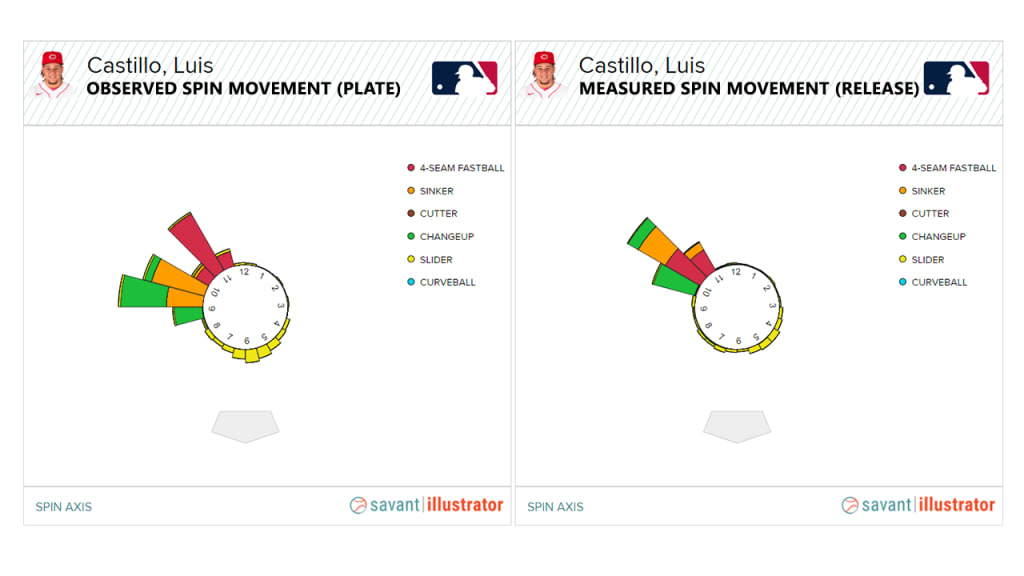
Or, lastly, Kyle Hendricks of the Cubs, a soft tosser who nonetheless is regularly one of baseball's best starters. Like Bieber, this is somewhat about elite command and control, though Hendricks doesn't have the same type of velocity or stuff. But as you can see, his four-seamer, sinker and changeup all come out with very similar spin (right), which also mirrors his curveball. By the time it gets to the plate, those three non-curve pitchers are doing very different things. The "perception of deception," as Jeff Long once termed it, is a complicated yet powerful thing.
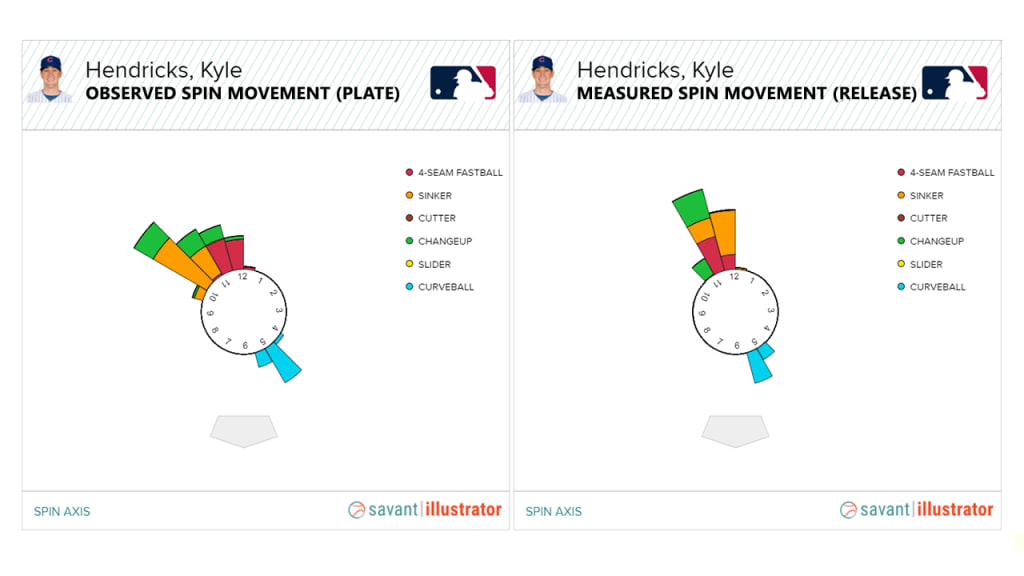
Or, we can use it to look at an incredibly dominant pitch that's simply unlike any other.
Williams and the changeup that isn't
Milwaukee's Devin Williams won the National League Rookie of the Year Award because he throws an absolutely deadly changeup, one that collected 108 called strikes or swinging strikes while allowing just two hits. That is, if it's even a changeup at all.
It's classified as a changeup because he calls it a changeup, but it's not really like any changeup anyone else throws in baseball. That's sort of what makes it so dominant -- it's a truly unique pitch, one that deserves a unique name. That's how Baseball Twitter came to land on "the Airbender," first popularized by Rob "the Pitching Ninja" Friedman.
We don't have an official classification for "Airbender," or a "backwards slider," as he told The Athletic he sees it. But you can see by looking at the changeup spin direction list that he's out there all on his own. Just about every righty changeup has a release spin direction between 9:30 and 11:15, because most of the point of a changeup is to play off the fastball. (For example: Lucas Giolito's four-seam has a 11:15 direction, while his very good changeup has a 10:45. Neither changes on the way to the plate, aside from the 14 mph gap.) Williams is down at 8:30, because he's not really trying to play the changeup off the fastball. It's a separate pitch entirely.
You can see that visually here. Giolito's chart looks like a lot of other righty pitchers, like Hendricks or Zach Davies or Sixto Sánchez, in that they're trying to get their changeup spin direction to look like their fastball out of the hand, then kill that spin on the way to the plate. Williams isn't trying to bother. That's because it's barely a changeup.
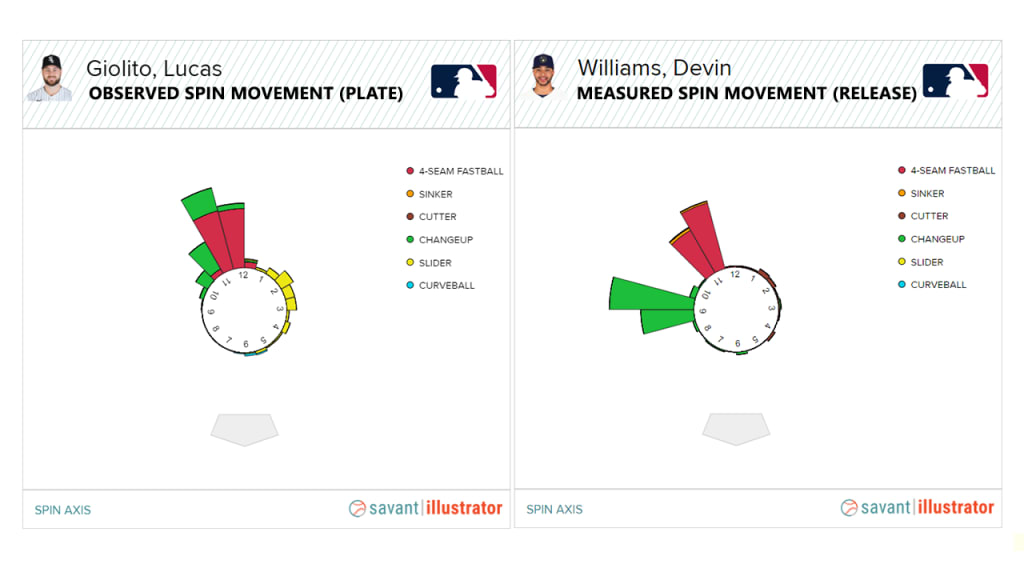
No righty changeup is delivered with that kind of spin, with one exception. Baltimore's Cesar Valdez does it the same way as Williams, but Valdez is his own kind of unicorn, throwing a 77.9 mph pitch nearly 85% of the time. (His pitch is called "the dead fish," which we'll argue is not quite as intimidating as "Airbender.")
And that all, really, is the point. Nearly two centuries into this game existing in America, we're still learning more and more about it every day. Find your favorite pitcher over at Baseball Savant here.
